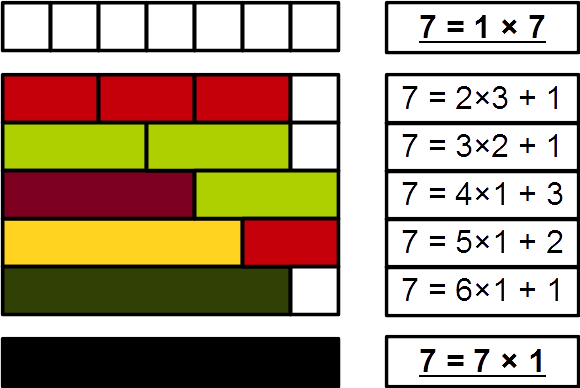Facts for Kids
A prime number is a whole number greater than 1 that cannot be divided evenly by any other whole number except for 1 and itself.
Overview
Prime Number Theorems
History Of Prime Numbers
Examples Of Prime Numbers
Definition Of Prime Numbers
Properties Of Prime Numbers
Fun Facts About Prime Numbers
Prime Numbers In Nature And Art
Methods For Identifying Prime Numbers
Applications Of Prime Numbers In Cryptography
Famous Unsolved Problems Involving Prime Numbers

Inside this Article
Eratosthenes
Information
Science
Euclid
Nature
Fact
Are
Don
Did you know?
🌟 Prime numbers can only be divided evenly by 1 and themselves.
📏 The smallest prime number is 2, which is also the only even prime number.
🎉 A prime number cannot be made by multiplying two smaller whole numbers together.
🕰️ The study of prime numbers goes back thousands of years, with ancient Greeks being among the first.
🌈 Except for 2, all prime numbers are odd.
🤔 Prime numbers are never consecutive; there's always at least one non-prime number between them.
🕵️♂️ A simple way to identify prime numbers is to test if they can be divided evenly by smaller numbers.
🔒 Prime numbers are crucial in keeping our online information safe through cryptography.
🎓 The Prime Number Theorem helps us understand the distribution of prime numbers as we look at larger numbers.
🌼 Prime numbers can be found in nature and art, for example, certain flowers have petals in prime numbers.
Introduction
This means they cannot be made by multiplying two smaller whole numbers together! For example, the number 7 is prime since you can only divide it evenly by 1 and 7. The smallest prime number is 2, and it's also the only even prime! 📏
Prime numbers are used in many areas of math and science, making them a big deal for everyone, not just math whizzes!
Prime Number Theorems
One of the most famous is the Prime Number Theorem, which helps us understand how many prime numbers there are as we look at bigger and bigger numbers. It tells us that primes become less frequent but never truly vanish as numbers grow larger. This means that there are always more primes waiting to be discovered!
History Of Prime Numbers
️ The ancient Greeks were among the first to study them, with a famous mathematician named Euclid discovering important parts of prime numbers around 300 BCE. 📜
Euclid wrote a book called "Elements," where he explained that there are infinitely many prime numbers! Today, mathematicians continue to explore primes and learn new things about them.
Examples Of Prime Numbers
All of these numbers can only be divided by 1 and themselves. If you look at the numbers that come before and after them, you’ll see they don’t have any “meet-up” buddies because they are unique! 14, for example, isn’t prime since it can be divided by 2 and 7.
Definition Of Prime Numbers
This means that if you try to divide a prime number by any other number, you won’t get a whole number (unless you’re dividing it by 1 or the number itself). For example, the number 5 is prime because it can only be divided evenly by 1 and 5! ✅
Properties Of Prime Numbers
For instance, we already know that they can only be divided by 1 and themselves. But did you also know that except for 2, all prime numbers are odd? 🤔
This is because any even number greater than 2 can be divided by 2. Additionally, prime numbers are never consecutive, meaning there’s always at least one non-prime number between them!
Fun Facts About Prime Numbers
Did you know that the largest known prime number is over 24 million digits long? It’s called a Mersenne prime! Also, the number 1 is not considered prime. Another quirky fact is that the number 2 is the only even prime number, making it quite special! Keep exploring to uncover more amazing things about primes! 📚
Prime Numbers In Nature And Art
In nature, certain flowers, like daisies, often have petals in numbers that are prime! 🌸
In art, some artists purposefully use prime numbers to create visually pleasing patterns and designs, making their work interesting and unique. Whether you look at flowers or paintings, you might spot primes all around you!
Methods For Identifying Prime Numbers
️♂️ One simple way is to test each number to see if it can be divided evenly by any smaller number! Start with 2 and check all the way up to the square root of the number you’re testing. If no division works out evenly, it’s prime! There are also fun shortcuts like the Sieve of Eratosthenes, an ancient technique to find all primes up to a certain number quickly! 🎈
Applications Of Prime Numbers In Cryptography
This is called cryptography. Many websites use prime numbers to create codes that protect your personal data, like passwords and bank details. By using large prime numbers in math formulas, they make it super hard for anyone to crack the code! So next time you’re shopping online, remember that primes are working hard to keep you safe! 🛒
Famous Unsolved Problems Involving Prime Numbers
One famous problem is the "Goldbach Conjecture." It suggests that every even number greater than 2 can be expressed as the sum of two prime numbers, like 4 = 2 + 2, or 6 = 3 + 3. 📊
Even though many examples have been checked, no one has been able to prove it true for all even numbers!

